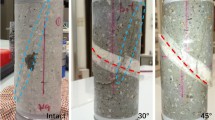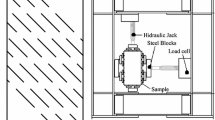Summary
Traction Problems on an Elastic Jointed Rock Half-Space
A rock mass with a major set of parallel, planar joints is considered for the case when the joint spacing is small compared with the length scales of interest, and large compared with the relative displacements across the joints. A continuum theory is adopted and under the additional assumption that the joints have finite elastic stiffnesses associated with their tangential and normal response prior to slip, the rock may be shown to be transversely isotropic about the direction of the joint normal. The class of problems for which analytic solutions are available for a transversely isotropic medium is very limited. However, for the case of low joint stiffnesses an approximate potential theory, analogous to that of inextensible fibre reinforced elastic materials, is available and may be applied to a much more general set of domains. Both the approximate theory and the exact transversely isotropic theory for low joint stiffnesses are applied to plane strain traction problems on a half-space in which the joints are inclined at varying angles to the boundary. Comparisons of the two theories are made for various values of the rock parameters and the joint angle.
Zusammenfassung
Zugspannungsprobleme in Felshalbräumen mit Klüften, die sich elastisch verhalten
Eine Felsmasse mit einer größeren Anzahl von parallelen, ebenen Klüften wird unter der Annahme untersucht, daß die Kluftweite gegenüber den betrachteten Längenabmessungen klein ist und gegenüber den relativen Bewegungen quer zu den Klüften groß ist. Mit Hilfe einer Kontinuumstheorie kann unter der Annahme, daß die Klüfte, bevor sie gleiten, eine endliche elastische Steifheit in Kluftrichtung und normal dazu besitzen, gezeigt werden, daß der Fels transversal-isotrop bezüglich der Kluftnormalen ist. Die Klasse der Probleme, für die analytische Lösungen für ein transversal-isotropes Medium existieren, ist sehr begrenzt. Jedoch für den Fall geringer Bindungssteifigkeit gibt es eine Näherungspotentialtheroie, ähnlich jener für undehnbare, glasfaserverstärkte elastische Materialien, die viel allgemeiner angewendet werden kann. Sowohl die Näherungstheorie als auch die exakte transversal-isotrope Theorie für kleine Fugensteifheit wird auf ebene Zugspannungsprobleme in einem Halbraum angewandt, in welchem die Klüfte in verschiedenen Winkeln zur Grenzebene geneigt sind. Für verschiedene Werte der Felsparameter und der Winkel der Klüfte werden Vergleiche angestellt.
Résumé
Les problèmes de traction sur un roc demi-espace joint élastiquement
Une masse de roc avec un ensemble majeur de parallèle, les joints planar, est considérée dans le cas où l'espace de joint est petit en comparaison avec la longueur des échelles considérées, et large en comparaison avec le décalage relatif à travers les joints.
Une théorie continue est adoptée et sous la supposition additionnelle qui stipule que les joints ont des raideurs élastiques finies, associés avec leurs tangentielle et normale reponse antérieur à glisser. Il pourrait être démontré que le rock peut-être transversalement isotropique en ce qui concerne la direction des joints normaux. La classe des problèmes pour lesquels des solutions analytiques sont valables pour un milieu transversalement isotropique est très limitée.
Cependant, pour le cas des petites raideurs de joint, une théorie de potentiel approximative analogue aux matériaux élastiques renforcées d'une fibre inextensible est disponible, et peut-être appliquée pour un ensemble de domaines plus généralisés. La théorie approximative et la théorie de l'isotropie transversale pour les petites raideurs de joint, sont à la fois appliqués aux problèmes d'effort de traction plane dans un demi-espace dans lequelle les joints sont inclinés à des angles variés par rapport à la limite. La comparaison des deux théories est réalisée pour diverses valeurs des paramètres du roc et de l'angle de joint.
Similar content being viewed by others
References
Jaeger, J. C.: Behaviour of Closely Jointed Rock, Chapter 4, Eleventh Symposium Rock Mechanics (Berkeley), Port City Press. 1969.
Jaeger, J. C., and Cook, N. G. W.: Fundamentals of Rock Mechanics, Methuen 1969.
Lekhnitskii, S. G.: Theory of Elasticity of an Anisotropic Elastic Body, Holden-Day 1963.
Morland, L. W.: Continuum Model of Regularly Jointed Media, Rept. R-72-1310, DASA 01-69-C-0159 (P00004), pp. 3–40, Syst., Sci. and Software, La Jolla, California 1972.
Morland, L. W.: A Plane Theory of Inextensible Transversely Isotropic Elastic Composites. Int. J. Solids Structures,9 pp. 1501–1518, 1973.
Morland, L. W.: 1974a. Continuum Model of Regularly Jointed Mediums. J. Geophys. Res.,79 pp. 357–362.
Morland, L. W.: 1974b. Elastic Response of Regularly Jointed Media. Geophys. J. R. astr. Soc.,37 pp. 435–446.
Morland, L. W.: 1975. Elastic Anisotropy of Regularly Jointed Media. Rock Mechanics (in press).
Muskhelishvili, N. I.: 1963. Some Basic Problems of the Mathematical Theory of Elasticity. Noordhoff Ltd., Groningen, Netherlands.
Rogers, T. G., and Pipkin, A. C.: Small Deflections of Fibre Reinforced Beams and Slabs. J. appl. Mech.38 pp. 1047–1048, 1971.
Author information
Authors and Affiliations
Additional information
With 12 Figures
Rights and permissions
About this article
Cite this article
Hall, R.W. Traction problems on an elastic jointed rock half-space. Rock Mechanics 12, 115–135 (1979). https://doi.org/10.1007/BF01239953
Received:
Issue Date:
DOI: https://doi.org/10.1007/BF01239953




